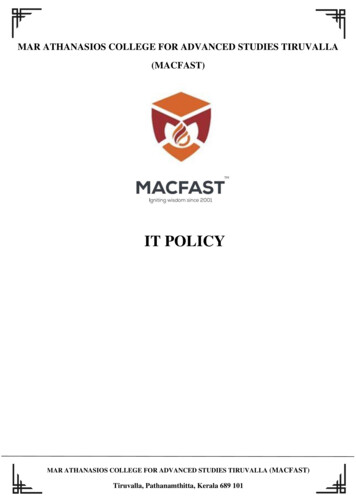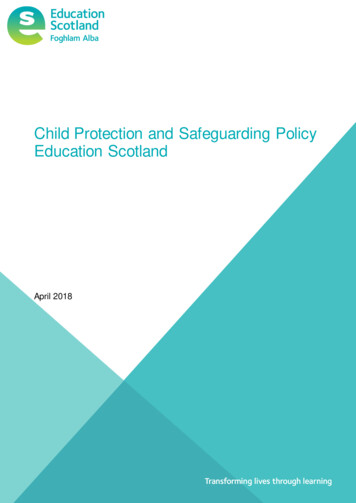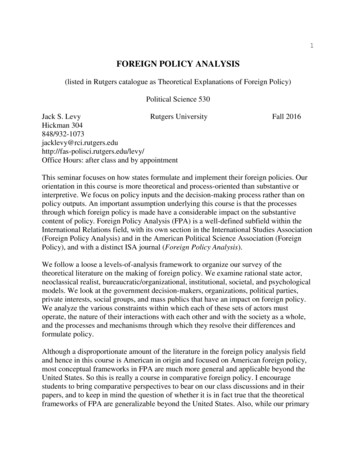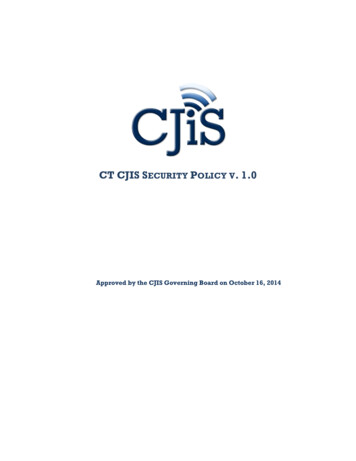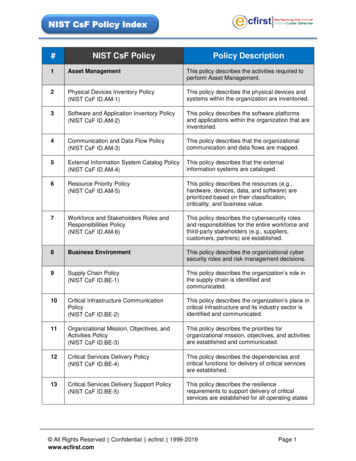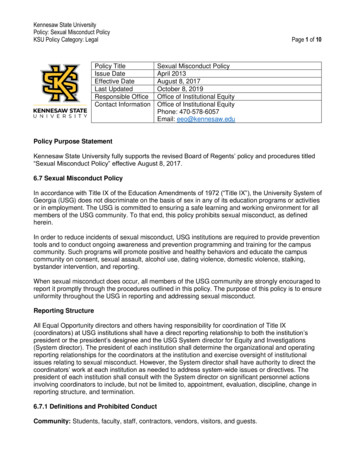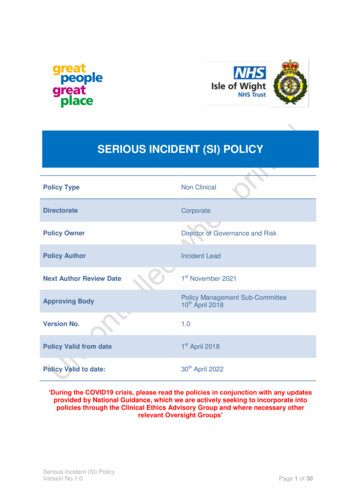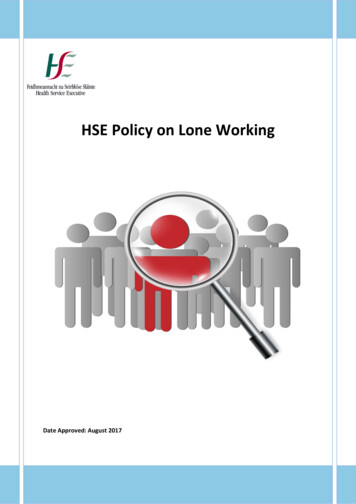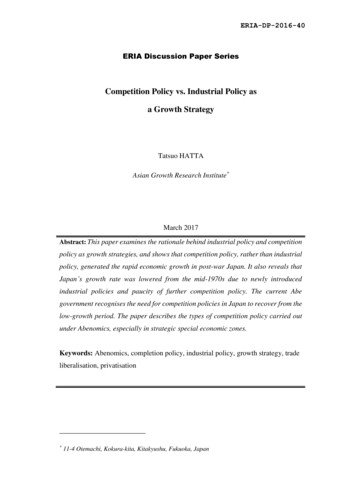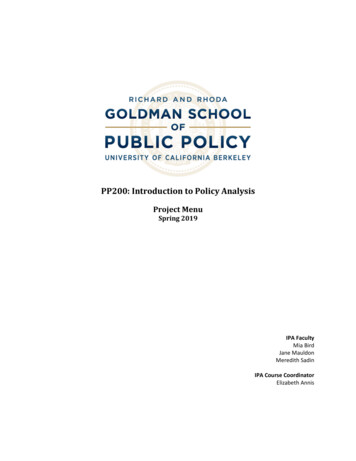
Transcription
PP200: Introduction to Policy AnalysisProject MenuSpring 2019IPA FacultyMia BirdJane MauldonMeredith SadinIPA Course CoordinatorElizabeth Annis
TABLE OF CONTENTSProject TitlePolicy AreasPage #1. Digital Equity in Long Beach: Survey Findings to act on toimprove access to reliable internet for all residentsScience & Technology: Innovation;Communications and Internet Policy12. Designing and Regulating Bike Lanes and Multi-UserPathways in the Bay AreaTransportation / Public Infrastructure23. Analysis and policy recommendations to inform BeyondCoal campaign "coal to clean energy" strategy for municipalutilitiesEnergy and Environment34. Easing the pain of high-cost prescription drugs forVirginians in needPublic Health; Health care provision;Pharmaceutical Regulation; Drug Policy55. Establishing a Model for Successful System Dosage forHomelessness Intervention in Contra CostaSocial Exclusion: Elder Policy; Poverty;Marginality; Housing provision / Urban Planning66. How should federal programs more cost-effectivelyincentivize environmental improvements on farms?Energy and Environment77. Pathways to Sustainable Jobs: Influencing ModernApprenticeships in CaliforniaEducation (Pre-K, K-12 and College) / Training88. UCSF Anchor Institution Strategic Implementation PlanSocial Exclusion: Elder Policy; Poverty;Marginality; Public Health; Health care provision99. The Socio-Economic Impacts and Politics of AutomatedDriving SystemsLabor / Employment Policy1010. Audience Targeted Strategic Dashboards (ATSD) formonitoring the 2018-2022 National Development Plan ofColombiaEconomic Development1111. Are Elementary School Report Cards SystematicallyInflated? If So, What Can Be Done About It?Education (Pre-K, K-12 and College) / Training1212. Creating a Template for Missing Middle Construction inOaklandHousing provision / Urban Planning1313. Identifying, Advocating, and Finding Solutions to OverPolicing in Oakland’s Vulnerable CommunitiesCriminal Justice1414. Predictive Analytics and Power Asymmetry: An Analysisof Emerging Workplace Monitoring Software and PotentialPolicy ResponsesLabor / Employment Policy; Science &Technology: Innovation; Communications andInternet Policy1615. Evaluating and Strengthening the Fair Chance Act:Ensuring Opportunity in the Workforce for FormerlyIncarcerated PeopleCriminal Justice18
16. Saving DC's Small Businesses: What is the cost of abroken regulatory system?Labor / Employment Policy; EconomicDevelopment1917. Taking Action on Climate Resilience: A GovernanceStructure for Contra Costa CountyGovernance; Energy and Environment2018. Business Improvement Districts and Their Impacts onOur Communities; From Creation to ImplementationHousing provision / Urban Planning2119. Understanding the challenge of "re-entry" after a lifesentence in prisonCriminal Justice2220. Examining and Addressing Policy Barriers to AffordableHousing Ownership through Community Land TrustsHousing provision / Urban Planning2321. Evaluation of Soda Tax Revenue Investments: are theyimproving health and wellness of communities sufferingfrom diet-related diseases?Economic Development; Public Health; SocialExclusion: Elder Policy; Poverty; Marginality2422. Smart Cities: How are mayors around the globe usingcutting-edge technology to combat climate change?Energy and Environment; Social Exclusion: ElderPolicy; Poverty; Marginality2523. Impact Evaluation and Strategic Assessment: CRLA’sNaturalization Efforts for Rural CaliforniansImmigration2624. Exploring the Impacts of the Expedited CondominiumConversion Process on Unauthorized Dwelling UnitsRemovalsHousing provision / Urban Planning2725. Assisted Living Waiver: Is this the Key to Caring forCalifornia’s Growing Elderly Population?Public Health; Health care provision2926. Fines and Fees Baltimore: Analyzing Policies andPractices to Advance Inclusive LegislationCriminal Justice3127. Analyzing the Animal Hospital industry to support LaborOrganizingLabor / Employment Policy33
1. Digital Equity in Long Beach: Surve y Findings to act on to improve accessto reliable inte rnet for all residen tsClient: City of Long Beach, Mayor's OfficeProject Description: Equitable access to the internet is a priority for the City of Long Beach. We've recentlygiven a survey to over 1,000 residents on digital access. We provided this survey through community-basedorganizations, libraries, parks and other locations in person on paper to ensure those without access to theinternet are able to participate. These survey responses need to be analyzed to determine which aspects ofdigital access are important to residents and the City has purview to act on. For example, could the city havethe largest impact by working with ISPs on where 5G towers are placed? Or is it more important to focus onreevaluating Long Beach's Fiber Master Plan to include more of a resident focus? What are the needs seenthrough survey results we can best act on to improve access to reliable internet to residents of Long Beach?Client Information: The Mayor drives all policy in the City of Long Beach. As his senior staff I can directdepartments to take action.Policy Areas: Science & Technology: Innovation; Communications and Internet Policy1
2. Designing and Regula ting Bike Lanes and Multi-Use r Pathways in the BayAreaClient: Bike East BayProject Description: This project seeks to answer two questions focused on the design and regulation of bikelanes. First, what is the appropriate design for protected bike lanes and multiuser pathways so they canaccommodate access for people with a disability? People with a disability who park their cars along aprotected bike lane have to access the sidewalk across the protected bike lane. How might this best beapproached? There are many current policy considerations and challenges that have not been worked outpresently. Bike East Bay is working with the cities of Berkeley and Oakland to design protected bike lanes thatare ADA accessible. A design for protected bike lanes that is fully ADA compliant has yet to be developed.There are policies and design considerations for both ADA accessibility in the public realm, and there aredesign guidelines for protected bike lanes. These two sets of guidelines do not line up and match each otherand cities are struggling to find the most appropriate compromises and that as much of both sets of goals aspossible. While this project could involve design challenges, it is not meant as a design project. Students willevaluate existing policies that govern both ADA access and protected bike lanes, evaluate some exampleprojects, and come up with a framework for designs that work best, given all the public policies that governthis area. There are many local projects for the student team to look at. Students will review ADA guidelinesfor public right of way, as well as general ADA principles, and review best practices for protected bike lanedesigns as outlined by various national agencies. A workable framework for designing protected bike lanes tobest practices will necessitate an evaluation of project cost tradeoffs, current state of ADA access in publicrealm, potential new policies needed moving forward, safety benefits and tradeoffs from a public policyperspective. Final work product from the students will be used by Bike East Bay as we continue to advocatefor and work with cities in the East Bay to build protected bike lanes for all users of the space, in Berkeley,Oakland and Richmond in particular, and then more broadly.The second question focuses on the regulation of faster-moving personal electronic devices in bikelanes/multi-user pathways where pedestrians or slower moving bikes and scooters are present. Bike East Bayis currently working with the cities of Berkeley and Oakland on new scooter ordinances, which when adoptedin December 2018 will allow for officially permitted operations of scooters on city streets. In Richmond, weare working with the Mayor’s office to develop city policies around how Richmond’s many multiuserpathways are regulated. As a non-profit bicycle advocacy group, we are also advocating for these cities tobuild more protected bike lanes for both bikes and scooters. What devices, in addition to bikes, should beallowed in protected bike lanes? People on ebikes are naturally going to want to use protected bike lanes, asare other people on speed assisted devices (scooters, electric skate boards, hover boards, etc.). People onpetroleum powered devices such as truly “motorized” scooters (Vespas, etc) are going to want to useprotected bike lanes. Should they be allowed? What are the pro’s and con’s? On multiuser pathways, shouldebikes and escooters be allowed? How should pathways and protected bike lanes be treated similarly ordifferently? Should the focus being on policies to govern the technology on multiuser pathways? Or thepriority be to regulate the behavior of people using them? There may be conflicting policies involved thathave to be worked out.The student team may choose to answer both questions for the client or only focus on one.Client Information: Bike East Bay promotes healthy, sustainable communities by making bicycling safe,fun and accessible.Policy Areas: Transportation / Public Infrastructure2
3. Analysis and policy recommendations to inform Beyon d Coal campaign"coal to clean ene rgy" strategy for municipal utilitiesClient: Sierra Club, Beyond Coal CampaignProject Description: The purpose of this project is to develop a report that outlines tools and strategies onhow to wean municipalities off of their reliance on coal fired generation and leave clean energy in its place.Objectives: While generally smaller in size, there are a large number of coal plants owned by municipalutilities or municipal energy agencies (munis). There are additional plants that, while not owned by a muni,directly serve a muni through a contract (power purchase agreement, or PPA). And finally, many munis relyon coal for electricity because they rely on the local utility or energy market to provide them with electricity,some portion of which is likely to come from coal (some exceptions apply).Significance: Not only is coal burning responsible for one third of US carbon emissions—the main contributorto climate disruption—but it is also making us sick, leading to as many as 13,000 premature deaths every yearand more than 100 billion in annual health costs. The Beyond Coal campaign’s main objective is to replacedirty coal with clean energy by mobilizing grassroots activists in local communities to advocate for theretirement of old and outdated coal plants and to prevent new coal plants from being built.Background: Municipal utilities play a large role in the electricity system all throughout the U.S. accountingfor an estimated 12% of retail sales. We are open to establishing a geographic focus for part of the projectand may select a few key states/munis to work on (options include Iowa, Michigan, Missouri, and Florida). Inthe Beyond Coal campaign, securing coal plant retirements and their clean energy replacement requires deepknowledge of utility governance, decision-making, and future options. The Beyond Coal campaign has hadsuccess in retiring coal plants owned by munis (over 3,600 MW and 70 units) but has not conducted asystematic, retrospective analysis of these retirements. Additional capacity is needed to formulate effectivestrategy on transitioning the remaining coal plants owned by munis.Available data: Sierra Club has access to datasets describing coal plants owned by or in contract with munis,including operational characteristics, emissions, and costs. We have basic documentation confirming howand when coal units were retired. This data will be shared with the team. Munis often have their owndatasets available via the web, and many have integrated resource plans (IRPs) which can provide a richresource into understanding how munis make decisions regarding electricity procurement and planning.Additionally, we can make introductions to Beyond Coal campaign representatives across the country,according to project scope and staff availability, though primary contact will be with the Beyond Coal’sresearch and analysis team.Possible approaches: We propose a third of the work should be focused on understanding campaignsuccesses to date for munis, focusing on successes that could be translatable to other cities. The researchshould cover both the means and the ends of retirement. The means would cover both utility governanceand decision-making as well as outside pressure (from Sierra Club and partners) including litigation, planninginterventions, direct organizing and advocacy, and legislation. The ends would cover coal’s replacement withgas or clean energy and other outcomes, if applicable.Armed with the knowledge produced by the retroactive evaluation, two-thirds of the work will be dedicatedto a forward looking approach: researching the tools and strategies of the future that munis can use to exitcoal contracts early and/or enter into clean energy contracts to decrease reliance on coal. The team mayexamine the benefits of various finance tools, including but not limited to: self-build renewables w/monetization of ITC/RECs; accelerated depreciation/ re-financing / securitization; creating regulatory assetsto hold debt associated with coal power plant investments; using PURPA statutes to get off coal; signing PPAsfor clean energy; and beyond the realm of finance. The team should also address how the governance of3
munis can impact decision-making with regards to energy planning. The research should encompass not onlyhow munis contract for energy but also how they contract for capacity. When coal plants retire, we need toaddress how munis make up the gap in both energy and capacity left behind. The project will require somebackground in economics, finance, and policy analysis. Background in the electricity sector will be extremelyvaluable.Deliverables: Final written report with 1) analysis on successes retiring coal plants owned by munis to dateand 2) recommendations for effective tools that munis can use to exit coal contracts early and/or enter intoclean energy contracts to decrease the amount of coal-fired generation purchased. The 2nd task can benarrowed in terms of geographic scope, while the scope of the 1st task can be tailored, as needed.Client Information: The research and analysis team of the Beyond Coal Campaign is managed by Kim Kohl.Our analysis team works with campaign directors and staff day in and day out, helping to make sure their onthe-ground strategy with utilities and our partner organizations is data-informed. Policy analysis coming forthfrom the IPA project will be used by campaign representatives directly in their work on municipal utilities inthe states mentioned in the proposal. The Beyond Coal campaign has been active since 2010 and has over160 campaign staff nationwide dedicated to a just transition from coal to clean energy. Our campaigncombines legislative and utility-based advocacy with grassroots organizing, effective communicationsstrategies, and legal offense. Since 2010, our campaign has retired or received retirement commitments for276 coal plants (more than half) representing 134 gigawatts of capacity. There is still much work remaining,and municipally owned or contracted coal plants occupy an important sphere of this work. Concurrently, anew campaign at Sierra Club called Ready for 100 is mobilizing cities to commit to 100% renewable energypurchasing, with over 50 cities currently committed. The movement is much larger: the Conference ofMayors (representing over 1400 U.S. cities) adopted a resolution to move to 100% clean energy. At the SierraClub, the Beyond Coal campaign deputy directors and state campaign representatives (especially in stateswhere munis play a large role) will be the primary users of any research produced by the UC Berkeley team.The Ready for 100 campaign will be secondary users of the research produced. Finally, there is a movementin cities nationwide to transition to 100% clean energy that will also benefit from the research, in particularcities that are served by a muni.Supporting Materials: References Inside the war on coal – 5/05/inside-war-on-coal-000002 Beyond Coal website: https://content.sierraclub.org/coal/ Ready for 100 website: https://www.sierraclub.org/ready-for-100 From the Ashes film - documenting the Sierra Club Beyond Coal campaign:https://www.fromtheashesfilm.com/Policy Areas: Energy and Environment4
4. Easing the pain of high-cost prescription drugs for Virginians in needClient: Shelly Simonds for DelegateProject Description: The high cost of prescription medications is driving some Virginians to forgo necessarymedical treatment. Many low-income families can’t afford to pay for life-saving or life-extending drugs andprices are still escalating. The policy question we are trying to solve is: “How can the state provide betteraccess to affordable prescription medication for low- and middle-income Virginians in the face of escalatingdrug costs?”For this IPA, students will be expected to: 1) evaluate how the state of Virginia currently supports access toprescription medication for low- and middle-income families; 2) identify one or more areas ripe forimprovement; 3) conduct a best practice analysis of the policies and practices of any states that havesuccessfully addressed this problem; and 4) suggest legislation or innovative policies that Shelly couldpropose to solve the problem. Students will work closely with the Shelly Simonds for Delegate team inexploring best practices and creating a report that will inform Shelly’s campaign platform and futurelegislation. The main contact for the IPA is a GSPP graduate, Kate Ringness, who knows how to make an IPA avaluable experience. Kate’s office is conveniently located in downtown Berkeley and she will strive to createa collaborative and supportive working environment.Client Information: Shelly Simonds is a 2019 candidate for a seat in the Virginia State House of Delegates inDistrict 94, a district that includes Newport News and is currently heavily gerrymandered in favor ofRepublicans. Shelly ran for this seat in 2017, hoping to flip the VA House of Delegates in favor of theDemocrats. The race was declared a tie, and she lost the race in a coin toss. This time around, Shelly wants towin the election and be prepared to govern. She wants to have solid legislation ready to put forward to solvesome of the problems that cause her fellow Virginians immeasurable suffering. Shelly also has the ear ofmany sitting legislators and is in the position to offer legislative solutions even in her position as candidate.Policy Areas: Public Health; Health care provision; Pharmaceutical Regulation; Drug Policy5
5. Establishing a Model for Succe ssf ul Syste m Dosa ge for H omelessne ssIntervention in Con tra C ostaClient: Contra Costa Health Services – Health, Housing, and Homeless Services Division (H3)Project Description: There are a variety of interventions that H3 oversees as part of its homeless system ofcare. “Dosage” pertains to the intensity, duration, and type of contacts consumers and potential consumersmake with this system of care in order to move on to sustainable housing situations. Given that there are avariety of interventions, H3 seeks to understand if efforts should be centered on any in particular whichproduce effective outcomes generally, or for particular subpopulations. The student team will work withservice providers to determine the best way to measure "intervention dosage," and will draft policies andprocedures for documenting services throughout the year.What are the depth and breadth of program impacts? Should H3 emphasize different types or combinationsof interventions? Should a successful model be widely implemented; if so, how?The project purpose is to create a better way to offer services, and to what degree, to consumers withdifferent needs, within different programs. This project has the possibility to lead to a summer internshipopportunity at H3, wherein a student-intern who is familiar with the findings and policy recommendations ofthis project would work on their implementation and funding allocation.Client Information: H3 operates/oversees the system of care, in accordance with HUD regulations. Theorganization cannot work outside of these regulations, but may seek less restrictive solutions elsewhere, or afocus on other benefits that help ensure sustainable outcomes.Policy Areas: Social Exclusion: Elder Policy; Poverty; Marginality; Housing provision / Urban Planning6
6. How should federal programs more cost-effective ly incentivizeenvironmental improvements on farms?Client: The Breakthrough InstituteProject Description: Several government "conservation" programs reward farmers for using specificpractices, such as no-till agriculture, based on the assumption that the practices improve environmentaloutcomes in a cost-effective manner. However, these assumptions are not always well-founded. For instance,practices and technologies can have very different effects in different environments. No-till farming generallyreduces nitrous oxide emissions in dry regions, but increases emissions in moist areas. Conversely, some newpractices such as giving cattle methane inhibitors can demonstrably reduce environmental impacts, but arenot incentivized by existing programs and regulation. As a result, conservation program spending is usedinefficiently, encouraging farmers to use practices that don’t have the biggest bang-for-their-buck.With today’s availability of environmental and farm data, environmental incentive programs can bedramatically improved. In the past decade, the amount of data collected by farm equipment, satellites,drones, and farmers has grown exponentially. These data sources can be used to model or measure actualenvironmental improvements. For example, companies that provide farm management software claim theycan use the data they collect from farms to monitor how much farmers are reducing greenhouse gasemissions (GHGs) or nutrient loss levels. Conservation programs could generate greater environmentalimprovements if they leveraged this data when deciding where to allocate spending. This would represent aprofound change in how environmental performance is incentivized and rewarded in American agriculture.We are interested in how the United States Department of Agriculture (USDA) and potentially theEnvironmental Protection Agency (EPA) can better target agricultural environmental incentives to have thegreatest benefit, focusing particularly on GHGs and nutrient loss. There are several near-term policyopportunities to better use farm and scientific data to target spending. One option is for the USDA, whichadministers the conservation programs, to direct funding to farms based primarily on their expected costeffectiveness in addressing environmental problems. For instance, USDA could use soil, climate, yield, andcrop price data to model which farmers could most cost-effectively sequester carbon and pay themaccordingly. Other options include administering funding for certain environmental improvements through areverse auction mechanism, providing farmers with insurance premium deductions (or increased payments)based on their expected environmental benefits (or negative impacts), and creating a new food certificationsystem similar to the National Organic Program that provides a price premium to farmers with lowenvironmental footprints. There are likely many other possible policy options as well that student consultantscould consider examining.Client Information: The Breakthrough Institute is a research center that identifies and promotestechnological solutions to environmental and human development challenges. The output of this researchwould be a written report and a series of 1-3 presentations to Breakthrough’s staff and board, senior fellows,external non-profit partners, and/or members of the media with whom we’ve worked. These groups includeinfluential actors such as Jayson Lusk, head of the Department of Agricultural Economics at PurdueUniversity; Third Way, a DC advocacy-oriented think tank that is launching an agriculture & food policyprogram; foundations engaged in sustainable agriculture; and agricultural companies or industryassociations. As appropriate, we could also invite external experts we have not worked with but who areinfluential in food policy such as staff from Union of Concerned Scientists, the National SustainableAgriculture Coalition, and established agriculture journalists. Breakthrough would use the findings from theIPA to guide future analysis, and to inform the advocacy work of partners. This may include sharing the reportwith agricultural policy stakeholders to provide context for a workshop, adapting or referencing the analysisfor articles and op-eds, or sharing the findings with stakeholders through one-on-one meetings.Policy Areas: Energy and Environment7
7. Pathways to Sustainable Jobs: Influen cing Modern Apprenticeships inCaliforniaClient: Year Up, Inc.Project Description: Year Up California’s Priority to Align Systems to Employer DemandYear Up’s mission is to close the Opportunity Divide by providing urban young adults with the skills,experience, and support they need to enter professional careers and higher education. We are currentlyactive in 23 cities, serving over 4,000 young adults each year. Participants complete six months of collegelevel technical and professional skills training, followed by an opportunity to apply those skills at a six-monthinternship with one of Year Up’s 250 corporate partners.The IPA team will be asked to provide recommendations in the following domains: Operations: Explore how Year Up might expand the skills training we offer to participants, developnew employer partnerships, or improve or recreate our internal processes; Policy Impact: Identify policies/decisions we should look to influence (and strategies to do that),consistent with Year Up’s mission and principles outlined in “On-Ramps to Opportunity: ReimagingCalifornia’s Talent Marketplace”; Influence and Reputation within the Apprenticeship Landscape: Provide an overview oforganizations working as intermediaries in the apprenticeship space within California. Within thisanalysis, include which employers and training providers are working to host apprenticeships andpre-apprenticeships as defined by Assembly Bill 235. In light of this context, explore how Year Up canmaximize the opportunity to position ourselves as a leader in the realm of nontraditionalapprenticeships. Note that Year Up has established relationships with many C-Suite players acrossthe United States, therefore recommendations on how to address this level of management areencouraged.Counties of interest: Alameda, Contra Costa, San Francisco, San Mateo, Santa Clara, and Los Angeles.Cities of interest: San Francisco, Oakland, San Jose, Los Angeles, Stockton, SacramentoState of interest: CaliforniaClient Information: Year Up provides a year of career training to young adults who have earned high schooldiplomas or GEDs. With 18 years of experience as a national organization and 10 years in California, Year Upoffers a high support, high expectation model that combines marketable job skills, stipends, internships andcollege credits. Year Up graduates are prepared for employment in the technical, financial, and sales markets,in both public- and private-sector jobs. Typical roles include, but are not limited to: IT Help Desk, ProjectManagement, Sales Representative, Security Analyst, Data Analyst, and Quality Assurance positions. Someemployers have described Year Up as an apprenticeship program, although this is not technically accurate, asYear Up does not meet national apprenticeship requirements. In California, we are excited to explore howour Year Up leadership can best participate in the shifting apprenticeship landscape.Policy Areas: Education (Pre-K, K-12 and College) / Training8
8. UCSF Anchor Institution Stra tegic Implementation PlanClient: University of California, San FranciscoProject Description: UCSF recently completed the report, "Advancing Health Equity in San Francisco:Assessing UCSF's Institution Capacity and Recommendations for Strategic Direction," as a framework for UCSFto examine ways we can address social determinants of health to impact health equity. This report was donein partnership with a team of phenomenal GSPP students. The next step is to convene a process to translatethe report into a strategic implementation plan in collaboration with a robust set of stakeholders. Morespecifically, we will be reviewing the report and going through a facilitated process to prioritize therecommendations around workforce development, procurement and investment.There will be research, data collection, and analysis involved that are specific to human resources, supplychain, and social impact investment. The final product is an Anchor Institution Strategic Implementation Planfor UCSF.Client Information: The Center for Community Engagement (CCE) is the institution infrastructure created tocoordinate and deepen partnership between UCSF and under resourced communities to promote health equity.CCE is leading the charge to facilitate the anchor institution framework at UCSF. The Chancellor's Executive Teamhas reviewed the report and in the recent Chancellor's State of the University Address, Chancellor Hawgood notedthat he and his leadership team will be exploring a significant and long-term investment in this anchor work. TheStrategic Implementation Plan will potentially have significant impact on UCSF and our under resourcedcommunities, in San Francisco and beyond.Policy Areas: Social Exclusion: Elder Policy; Poverty; Marginality; Public Health; Health care provisio
3 3. Analysis and policy recommendations to inform Beyond Coal campaign "coal to clean energy" strategy for municipal utilities Client: Sierra Club, Beyond Coal Campaign Project Description: The purpose of this project is to develop a report that outlines tools and strategies on how to wean municipalities off of their reliance on coal fired generation and leave clean energy in its place.

